| Construction Rating: | starstarstarstarstar_border |
| Flight Rating: | starstarstarstarstar_border |
| Overall Rating: | starstarstarstarstar_border |
| Manufacturer: | Das Modell  |
| Style: | Scale |
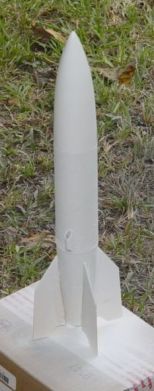
Brief:
This is the Das Modell Aggregat-4 (A-4) Peenemünde V2. It is designed by Thorwald Peterson of Noris Raketen's Das Modell in Nürnburg, Germany. It is a single-stage Skill Level 3 rocket kit that is not available for sale in the United States. I imported it from a hobby shop in Great Britain several years ago, along with the Saturn V, Space Shuttle and Phoenix kits. The finished V2 model stands at 16" tall. The A4 V2 is a semi-scale model based on the Von Braun vengeance weapon Peenemünde circa 1942.
Construction:
The kit came in an attractive full color cardboard box and was complete. It has a 1 7/8" airframe, unique shaped plastic nose cone and boat tail, 18mm motor mount with clip, fiberboard fins, clay nose weight, 30" plastic chute, two foot piece of tubular nylon, a bag of cotton wadding, German and English instructions, a UKRA checklist, and a decal.
Being a last minute modeler at times, I pulled this kit out of my rocket closet just 48 hours before needing it ready to fly. Houston's NHRC (NASA Houston Rocket Club) had a very unique event scheduled for Saturday September 18th called the Wacky Wockets/V2 Contest at NASA's Johnson Space Center in Clear Lake, Texas (near Houston). I opened the box at about 8AM on the previous Thursday the 16th, laid everything out and got to building. While there were two sets of instructions (as this was packaged for sale in the UK), I decided to use the German ones just for grins. The instructions are so well illustrated that you don't really have to be able to read them (and I do not speak or read German.)
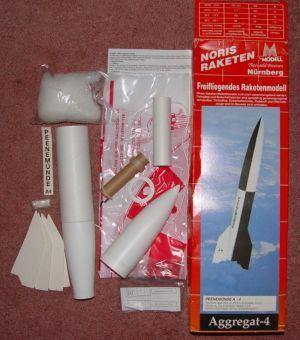 In the first step of building the rocket, I made a mistake. I adhered the airframe onto the boat tail without realizing that it would have been a lot easier to build and install the motor mount first. This was entirely my fault as I started with the wrong step and it did create a challenge during the build. In order to adhere the top ring of the motor mount to the inside of the boat tail I had to make a paper syringe out of a cardboard plate and sort of pour-squirt some 30 minute epoxy down into the motor mount by going through the top of the airframe. This was very tedious but ended up turning out perfect.
In the first step of building the rocket, I made a mistake. I adhered the airframe onto the boat tail without realizing that it would have been a lot easier to build and install the motor mount first. This was entirely my fault as I started with the wrong step and it did create a challenge during the build. In order to adhere the top ring of the motor mount to the inside of the boat tail I had to make a paper syringe out of a cardboard plate and sort of pour-squirt some 30 minute epoxy down into the motor mount by going through the top of the airframe. This was very tedious but ended up turning out perfect.
The fiberboard fins were pre-cut and appeared as if they would conform to the shape of the boat tail but they were a little off. I had to use some 240 grit sandpaper to re shape the root edges but this didn't really take long.
The recovery system was designed to use a two foot long piece of 1/8" tubular nylon secured to a cardboard motor mount type ring which also serves as a mini baffle. I used an X-Acto pin to punch two holes into the ring and installed a double loop of 50# Kevlarthread so that if one side ever burns through I will have a backup. While the tubular nylon was a nice feature, unfortunately it was too short. I added an eight foot long 1/8" sewing elastic shock cord that can be easily replaced. The plastic parachute that came with the model was a 30" Estes type with German print. I kept it as a novelty and selected an 18" red Top Flight Recovery nylon rip stop chute.
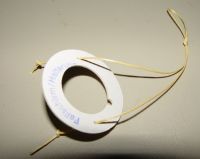
Finishing:
Finishing this model was simple. The fiberboard fins do not need to be sanded or sealed so I just shot it with a quick coat of white primer, then a few coats of gloss white. I may hand paint or tape off and spray paint the scale black panels later.
Construction Rating: 4 out of 5
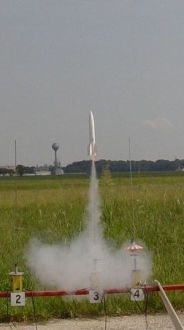
Flight:
The first flight was at NASA's Johnson Space Center in Houston Texas as part of the 2004 Wacky Wockets / V2 contest. I used the only motor recommended by Das Modell, which was the C6-3. Very nice high boost and twisted quite a bit.
Recovery:
Perfect deployment and landed on a giant hay bail about 400 feet west of the pad.
Flight Rating: 4 out of 5
Summary:
This is a unique V2 which is fairly simple to build, has nice quality components, and it's rare! Chances are no one else in your club has one or has ever seen one. It will draw some comments. Unfortunately these are extremely hard to get. I have wanted to purchase more Das Modell models and have emailed Das Modell many times but have never received a response. I even called them in a three way conversation with a friend in Germany speaking for me to ask if I could purchase more, but I was told to stop by their shop. Apparently they do not export their kits to the United States. As I will be in Nürnburg, Germany in January, I do plan on going by their store. Das Modell even produces engines, like the D7-5, which are not available in the US either. I plan on picking up some more kits and motors so I can ship them back to my home in Texas.
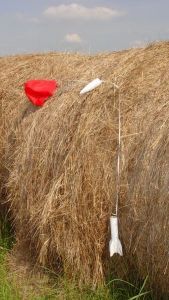
Overall Rating: 4 out of 5
I have more time into this build than what I would like to admit. I worked on it off and on over a 10 hour period, starting with Gel CA for the motor mount and then 28 minute CA for the fins. Altogether it took over 4 hours to build.
I was reminded of a valuable lesson during this build and that is don't procrastinate. I should have started this model at least a week before wanting to fly it, not two mornings before. I had a major nightmare happen when finishing up. I was using an Estes fin alignment guide and after getting all the fins on with the 28 minute epoxy along with some small brushed fillets, I noticed that a drop of epoxy was holding the motor clip in the open position as I was using a spent motor case to cause the rocket to stand at the proper height. Fearing that it would dry that way I carefully removed the rocket from the alignment guide, removed the engine and one by one the fins started to slide off. In a panic I laid the fins on some wax paper, cleaned up the mess, stuck a piece of wax paper between the clip and airframe, stuck the motor back in, put the rocket back on the stand/alignment guide and put the fins on a second time as the epoxy was starting to cure. This was frantic and would not have been such a big deal if I did not want to have the model ready for paint the next morning and ready to fly the day after.
The finished product is a nice strong little V2 that I feel good about. It looks great and if I can figure out how to pronounce it's correct name I am sure it will impress other club members on the field. :) I will most certainly build and fly more Das Modell kits and if you can find one, I highly recommend them.
 |
 |
K.S.W. (October 25, 2005)
Sponsored Ads
 |
 |


![Das Modell [Explicit] Das Modell [Explicit]](https://m.media-amazon.com/images/I/41qKaHtaSKL._SL500_.jpg)
![Das Modell [Single-CD] Das Modell [Single-CD]](https://m.media-amazon.com/images/I/51QkvXl8hQL._SL500_.jpg)
![Das Modell [Single-CD] Das Modell [Single-CD]](https://m.media-amazon.com/images/I/41qa4+2YypL._SL500_.jpg)







K.S.W. (October 3, 2004)